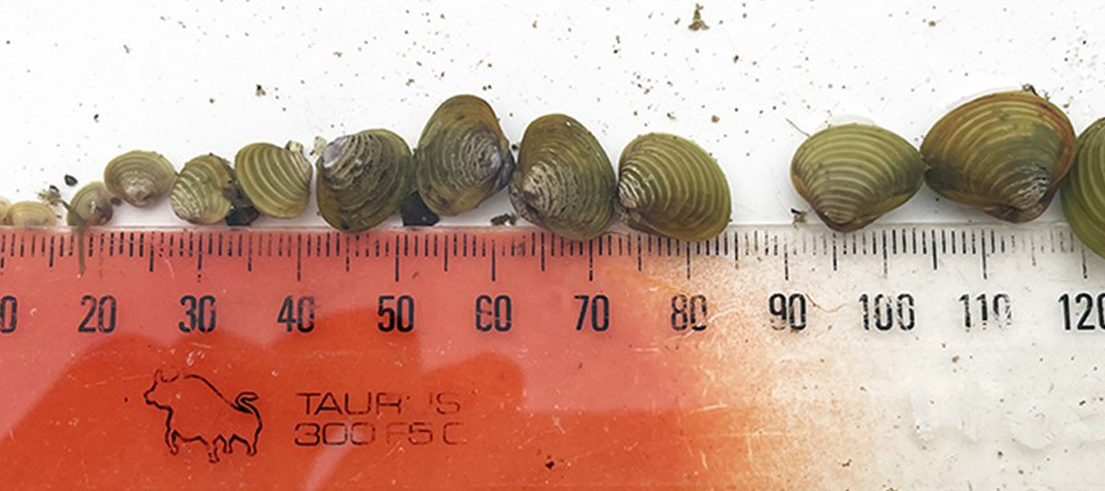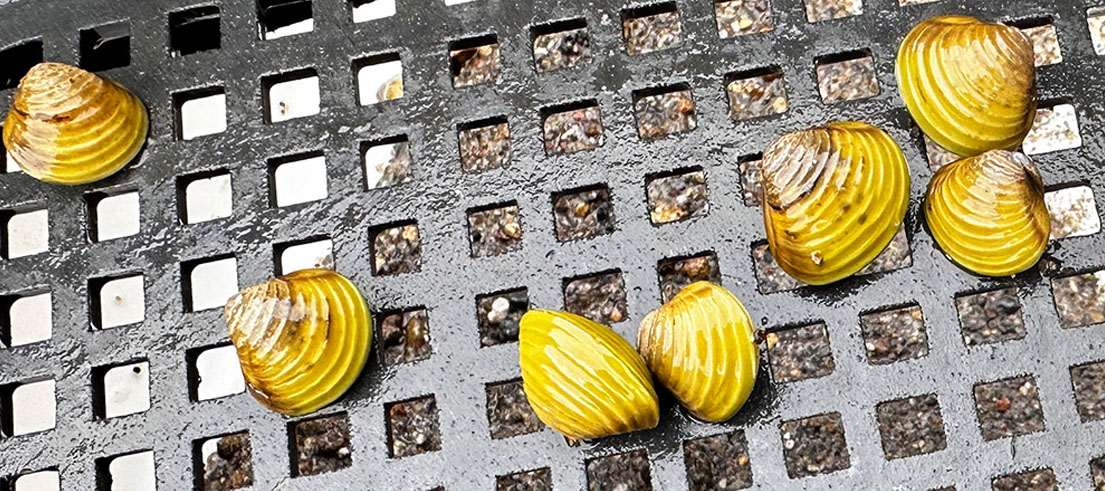Adult clams are 2-3cm in length, yellow, dirty white, or tan in colour, and have a ribbed texture on their shell. They can clog water-based infrastructure and can compete with native species for food.
Description
- Freshwater gold clams are quite distinctive and easily identified, as there are no similar-looking New Zealand species.
- They are found in freshwater or brackish water.
- Able to survive a wide range of temperatures and salinities.
- They are found within the water, sitting on top of sandy or muddy surfaces, or buried shallowly within them.
- Their shells may be partly exposed, or their syphons (their breathing tubes) sticking out from the sediment.
- They can also be found amongst debris, such as leaves, that may have settled on the riverbed.
What you need to know
Gold clams reproduce rapidly and form large populations that can clog water-based infrastructure such as electric generation plants, irrigation systems, and water treatment plants. They are filter feeders that can potentially compete with native species for food. Freshwater gold clams are prolific breeders, able to produce 400 juveniles a day and up to 70,000 juveniles a year.
Management approach
Unwanted organism
An unwanted organism is an organism classified as a pest by the Ministry for Primary Industries (MPI) because it is capable of causing harm to the natural environment, physical resources or human health in Aotearoa/New Zealand.
Rules
Any species declared a pest cannot be sold or be in a place where plants are being sold. Pests cannot be propagated, bred, multiplied, communicated, released, cause to be released, or otherwise spread.
See the MPI website for more information about unwanted organisms.
Control
Do not move or attempt to control gold clam yourself. Note the location, take a photo if possible and also the surrounding area and contact MPI on 0800 80 99 66 or complete the online reporting form.
Help stop the spread!
This overseas clam was first found in New Zealand in the Waikato River in May 2023. It has not yet been found to exist outside this area. Help protect Aotearoa’s waterways by making sure you check, clean dry between waterways.
Check
Remove any visible matter, including any clams you can see, along with plant material or mud. Drain all river or lake water.
Clean
Wash down your gear, vehicle, watercraft, and trailer that has been in contact with river or lake water with tap water onto grass, beside the waterway or at home and not into a stormwater drain system. This will remove any remaining invisible material.
For absorbent surfaces and materials that have been in contact with river or lake water (including carpets on trailers) use an appropriate treatment in the treatment options table below.
Treat residual water that always occurs when onboard ballast bladders or tanks have been pumped.
Dry
Allow gear to dry to the touch, inside and out, then leave it to dry for at least 48 hours (2 days) before using it again.
Dry areas inside the watercraft where water has pooled, for example with an old towel, and then leave the craft to dry for at least 48 hours (2 days). The hull of a watercraft will dry when towed.
| Type of treatment | Method |
|---|---|
| Hot water | Above 60 degrees celsius for at least 1 minute, or between 50 to 54 degrees celsius (hot household tap water) for at least 5 minutes, or above 45 degrees celsius for at least 20 minutes. |
| Freezing | Until solid (that is, freeze overnight). |
| Bleach | Mix household bleach in a 10 per cent (1 in 10) ration with water and immerse for 1 hour. |
| Isopropyl alcohol | 70 per cent isopropyl alcohol, taking care as it is toxic and flammable, and there are requirements around storage and transport of isopropyl alcohol. |








